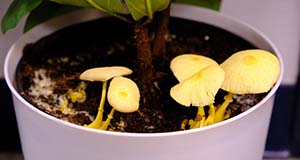Abstract
Mushrooms growing in potting soil are a common problem reported in nursery production and in potted plants in the indoor and outdoor home landscape. Many of these fungi are saprotrophic and feed on the organic matter contained in the potting soil itself and/or in the mulch, which varies in composition but often contains tree bark, wood chips, pine straw, moss, or leaves. These fungi are not necessarily harmful to the plants, but fungal fruiting bodies can make plants unmarketable. Unknown fungi can also be concerning to retailers and homeowners because of potential toxicity to pets and children. The purpose of this publication is to provide homeowners and retail nursery growers with an overview of some of the most common mushroom-forming fungi found in potted plants and potting soils in Florida. We also provide cultural control recommendations to help prevent or reduce mushroom growth.
References
Angelini, C., A. Vizzini, A. Justo, A. Bizzi, P. Davoli, and E. Kaya. 2020. “First Report of a Neotropical Agaric (Lepiota spiculata, Agaricales, Basidiomycota) Containing Lethal α-amanitin at Toxicologically Relevant Levels.” Frontiers in Microbiology 11: 1833. http://doi.org/10.3389/fmicb.2020.01833
Bessette, A. E., W. C. Roody, A. R. Bessette, and D. L. Dunaway. 2007. Mushrooms of the Southeastern United States. Syracuse, NY: Syracuse University Press.
Espinoza, L., and M. E. Smith. 2019. “The Green-Spore Poison Parasol Mushroom, Chlorophyllum molybites.” PP324. Gainesville: University of Florida Institute of Food and Agricultural Science. https://edis.ifas.ufl.edu/publication/PP324
Hall, I. R., S. C. Stephenson, P. K. Buchanan, W. Yun, and A. L. J. Cole. 2003. Edible and Poisonous Mushrooms of the World. Cambridge, UK: Timber Press.
Hallen, H. E., R. Watling, and G. C. Adams. 2003. “Taxonomy and Toxicity of Conocybe lactea and Related Species.” Mycological Research 107 (8): 969–979. http://doi.org/10.1017/S0953756203008190
Hopple Jr., J. S., and R. Vilgalys. 1999. “Phylogenetic Relationships in the Mushroom Genus Coprinus and Darkspored Allies Based on Sequence Data from the Nuclear Gene Coding for the Large Ribosomal Subunit RNA: Divergent Domains, Outgroups, and Monophyly.” Molecular Phylogenetics and Evolution 13 (1): 1–19. http://doi.org/10.1006/mpev.1999.0634
Karlsen-Ayala, E., R. Gazis, and M. E. Smith. 2021. “Asperosporus subterraneus, a New Genus and Species of Sequestrate Agaricaceae Found in Florida Nursery Production.” Fungal Systematics and Evolution 8 (1): 91–100. https://doi.org/10.3114/fuse.2021.08.08
Kimbrough, J. W. 2000. Common Florida Mushrooms. University of Florida, Extension Institute of Food and Agricultural Sciences.
Kraisitudomsook, N., and M. E. Smith. 2021. “Bird’s Nest Fungi: Charismatic Mushrooms in Your Garden: PP361, 12/2020.” EDIS 2021 (1): 3. https://doi.org/10.32473/edis-pp361-2020
Kraisitudomsook, N., R. A. Healy, and M. E. Smith. 2021. “Molecular Systematics and Taxonomic Overview of the Bird’s Nest Fungi (Nidulariaceae).” Fungal Biology 125(9): 693–703. https://doi.org/10.1016/j.funbio.2021.04.003
Martínez-Espinoza, A. D., M. Pearce, and L. L. Burpee. 2009. “Turfgrass Diseases in Georgia: Identification and Control.” Bulletin 1233. Athens, GA: University of Georgia Cooperative Extension. https://extension.uga.edu/publications/detail.html?number=B1233&title=turfgrass-diseases-in-georgia-identification-and-control
Matsuzawa, T., Y. Horie, T. Yaguchi, Y. Sakamoto, and T. Fukiharu. 2011. “Economic Damage to Cyclamen Growth by Sclerotia of Leucocoprinus birnbaumii.” Japanese Journal of Mycology 52(1): 38–42. https://www.jstage.jst.go.jp/article/jjom/52/1/52_jjom.H22-05/_article/-char/en
Petersen, R., and K. W. Hughes. 2021. “Collybiopsis and Its Type Species, Co. ramealis.” Mycotaxon 136 (2): 263–349. http://doi.org/10.5248/136.263
Redhead, S. A., R. Vilgalys, J. M. Moncalvo, J. Johnson, and J. S. Hopple Jr. 2001. “Coprinus Pers. and the Disposition of Coprinus Species sensu lato.” Taxon 50 (1): 203–241. https://www.jstor.org/stable/1224525
Vellinga, E. C. 2003. “Phylogeny of Lepiota (Agaricaceae)—Evidence from nrITS and nrLSU Sequences.” Mycological Progress 2: 305–322. https://doi.org/10.1007/s11557-006-0068-x

This work is licensed under a Creative Commons Attribution-NonCommercial-NoDerivatives 4.0 International License.
Copyright (c) 2024 UF/IFAS

